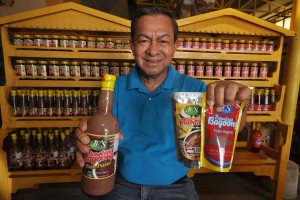‘Bagoong’ drives backyard businesses in Pangasinan
By Yolanda Sotelo
Inquirer Northern Luzon
LINGAYEN, Pangasinan—There must be something about the bagoong (fish paste) industry that made a couple abandon a plan to settle in the United States and stay here instead to tend to the business.
And there must be something about the native condiment for Lingayen to adopt it as its Otop (One Town, One Product), and for the local government to create an annual festival around this stinky mainstay in kitchens in the Ilocos region.
Although bagoong is produced in other towns or provinces, it has been associated with Lingayen, the capital town, along with furniture and “bocayo” (coconut candies).
Lingayen bagoong is one of the best products in the country, but it needs to undergo more development to compete with Thailand’s fish paste in the Asian market, Councilor Judy Vargas said.
Vargas counted 27 major producers in the town, excluding small, home-based factories, and they are continuously improving the taste, aroma and packaging.
The local bagoong used to be sold only in milk cans (locally called “litsi”) in the wet markets. It is now sold in bottles or pouches that line the shelves of upscale supermarkets and groceries.
One producer, Juanito Palisoc, 68, said DM’s factory was the first to process and bottle boneless bagoong in the town. Others followed suit, including Palisoc and his wife, Lily, who own JE’s Bagoong Products, which now packages other items such as sautéed shrimp fry (“ginisang alamang”), fish sauce (“patis”) and siganid (“padas”).
“First, I studied the products of factories that produced boneless bagoong, including those coming from Batangas province. Then I tried to produce a kind of boneless bagoong my own way, with the help of government agencies like the Bureau of Fisheries and Aquatic Resources (BFAR) and the Department of Trade and Industry (DTI),” Palisoc said.
His wife, who started the business in 1972 with five jars to ferment fish, simply could not leave the factory and join her husband in the United States, where they would have settled comfortably.
It was Palisoc who insisted on packaging the improved products after he attended seminars conducted by the BFAR and the DTI.
“Lily was against the packaging at first because we have enough market for our unpackaged product. But when she saw that it would hit another market, she agreed,” he said.
Palisoc said it was his wife’s dream to own a bagoong factory as she started working on one owned by a relative while she was in grade school.
“She learned all the techniques in making bagoong, including marketing, as she accompanied her relatives to different markets in the province,” he said.
The couple married in 1965, with Palisoc continuing his college education. When Palisoc started working in dam projects, Lily started her bagoong business.
Palisoc recalled that earthen jars (called “pasig”) were used to ferment bagoong. But since each jar can only hold four to six cans (12 liters each) of bagoong, they occupy plenty of space. To maximize space, they constructed concrete pits, each measuring 2 by 4 meters with a depth of two meters.
It takes up to three months to ferment “dilis” (anchovy), and seven to eight months for the bigger fish varieties.
The Palisocs get their supply of fish from as far as Bicol and the island provinces of Mindoro and Marinduque, where fish is salted before it is sent to Lingayen. They reprocess the salted fish, meticulously removing impurities and washing to remove sand, and salting them again.
Although Lingayen has a gulf bearing its name, the body of water cannot sustain the volume of fish needed by the bagoong industry.
The industry started with local fishermen who fermented the unsold fish they caught from the gulf, Palisoc said.
The shrimp and siganid fry they use in making bagoong still come from the gulf.
There are secrets on how Lingayen bagoong acquires the consistency and aroma that make it distinct from the rest, Palisoc said. One of these could be the use of salt from Dasol and Infanta towns in western Pangasinan.
“The salt from western Pangasinan has better quality than salt from other places,” Palisoc said.
JE’s (which comes from the initials of the Palisoc couple—Juanito and Ely, Lily’s nickname), has earned a following in the market, that even a regular customer from Nueva Ecija province had asked for labels to attach to cans of bagoong sold in wet markets.
Lily is still involved in the factory’s daily operations, to ensure the product’s quality.
“We do not want to produce and sell something that we won’t patronize and eat,” Palisoc said.
